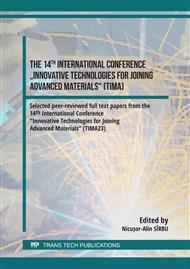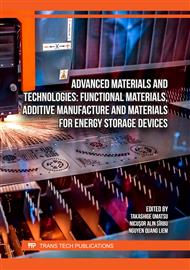[1]
Reverte, José María, et al. "Mechanical and geometric performance of PLA-based polymer composites processed by the fused filament fabrication additive manufacturing technique." Materials 13.8 (2020): 1924.
DOI: 10.3390/ma13081924
Google Scholar
[2]
Bembenek, Michał, Łukasz Kowalski, and Agnieszka Kosoń-Schab. "Research on the influence of processing parameters on the specific tensile strength of FDM additive manufactured PET-G and PLA materials." Polymers 14.12 (2022): 2446.
DOI: 10.3390/polym14122446
Google Scholar
[3]
Mazurchevici, Andrei Danut, Dumitru Nedelcu, and Ramona Popa. "Additive manufacturing of composite materials by FDM technology: A review." (2020).
Google Scholar
[4]
Caminero, Miguel Ángel, et al. "Additive manufacturing of PLA-based composites using fused filament fabrication: Effect of graphene nanoplatelet reinforcement on mechanical properties, dimensional accuracy and texture." Polymers 11.5 (2019): 799.
DOI: 10.3390/polym11050799
Google Scholar
[5]
Ferrer, Inés, et al. "Manufacturing PLA/PCL blends by ultrasonic molding technology." Polymers 13.15 (2021): 2412.
DOI: 10.3390/polym13152412
Google Scholar
[6]
Olmo, Cristian, et al. "Preparation of medicated polylactide micropieces by means of ultrasonic technology." Applied Sciences 9.11 (2019): 2360.
DOI: 10.3390/app9112360
Google Scholar
[7]
Maidin, Shajahan, et al. "Effect of ultrasonic vibration on the mechanical properties of 3D printed acrylonitrile butadiene styrene and polylactic acid samples." Heliyon (2023).
DOI: 10.1016/j.heliyon.2023.e17053
Google Scholar
[8]
Andó, Mátyás, Márton Birosz, and Sudhanraj Jeganmohan. "Surface bonding of additive manufactured parts from multi-colored PLA materials." Measurement 169 (2021): 108583.
DOI: 10.1016/j.measurement.2020.108583
Google Scholar
[9]
Brancewicz-Steinmetz, Emila, and Jacek Sawicki. "Bonding and strengthening the PLA biopolymer in multi-material additive manufacturing." Materials 15.16 (2022): 5563.
DOI: 10.3390/ma15165563
Google Scholar
[10]
Dilberoglu, Ugur M., et al. "Current trends and research opportunities in hybrid additive manufacturing." The International Journal of Advanced Manufacturing Technology 113 (2021): 623-648.
DOI: 10.1007/s00170-021-06688-1
Google Scholar
[11]
García-Collado, A., et al. "Advances in polymers based Multi-Material Additive-Manufacturing Techniques: State-of-art review on properties and applications." Additive Manufacturing 50 (2022): 102577.
DOI: 10.1016/j.addma.2021.102577
Google Scholar
[12]
Memarzadeh, Amin, et al. "Advancements in Additive Manufacturing of Polymer Matrix Composites: A Systematic Review of Techniques and Properties." Materials Today Communications (2023): 106449.
DOI: 10.1016/j.mtcomm.2023.106449
Google Scholar
[13]
Zhang, Yan, et al. "Prediction of deformation and failure behavior of continuous fiber reinforced composite fabricated by additive manufacturing." Composite Structures 265 (2021): 113738.
DOI: 10.1016/j.compstruct.2021.113738
Google Scholar
[14]
Karaş, Büşra, et al. "Additive manufacturing of high density carbon fibre reinforced polymer composites." Additive Manufacturing 58 (2022): 103044.
DOI: 10.1016/j.addma.2022.103044
Google Scholar
[15]
Zhuo, Peng, et al. "Material extrusion additive manufacturing of continuous fibre reinforced polymer matrix composites: A review and outlook." Composites Part B: Engineering 224 (2021): 109143.
DOI: 10.1016/j.compositesb.2021.109143
Google Scholar
[16]
Chang, Baoning, et al. "Ultrafast printing of continuous fiber‐reinforced thermoplastic composites with ultrahigh mechanical performance by ultrasonic‐assisted laminated object manufacturing." Polymer Composites 41.11 (2020): 4706-4715.
DOI: 10.1002/pc.25744
Google Scholar
[17]
https://www.roboze.com/en/3d-printers/roboze-one-pro.html
Google Scholar
[18]
Struzziero, Giacomo, Michel Barbezat, and Alexandros Antonios Skordos. "Consolidation of continuous fibre reinforced composites in additive processes: A review." Additive Manufacturing 48 (2021): 102458.
DOI: 10.1016/j.addma.2021.102458
Google Scholar
[19]
Alimuzzaman, Sk Md, and Muhammad P. Jahan. "Composite Based Additive Manufacturing." Practical Implementations of Additive Manufacturing Technologies. Singapore: Springer Nature Singapore, 2023. 117-151.
DOI: 10.1007/978-981-99-5949-5_6
Google Scholar
[20]
https://www.herrmannultraschall.com/en/
Google Scholar
[21]
Sharafi, S., et al. "A review of factors that influence the fracture toughness of extrusion-based additively manufactured polymer and polymer composites." Additive Manufacturing 38 (2021): 101830.
DOI: 10.1016/j.addma.2020.101830
Google Scholar



